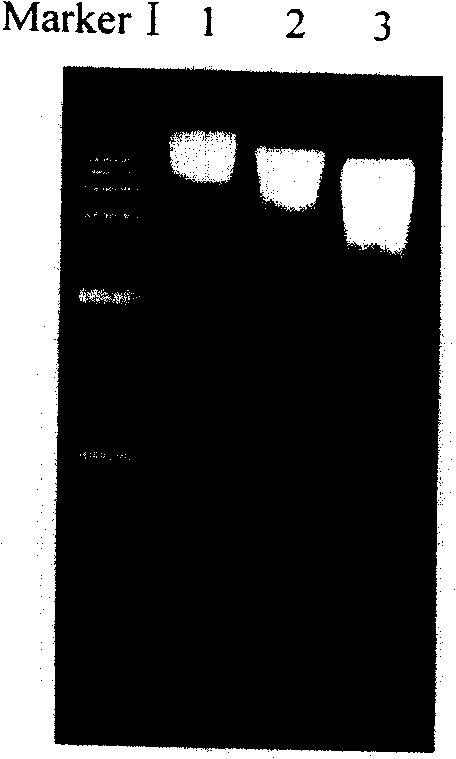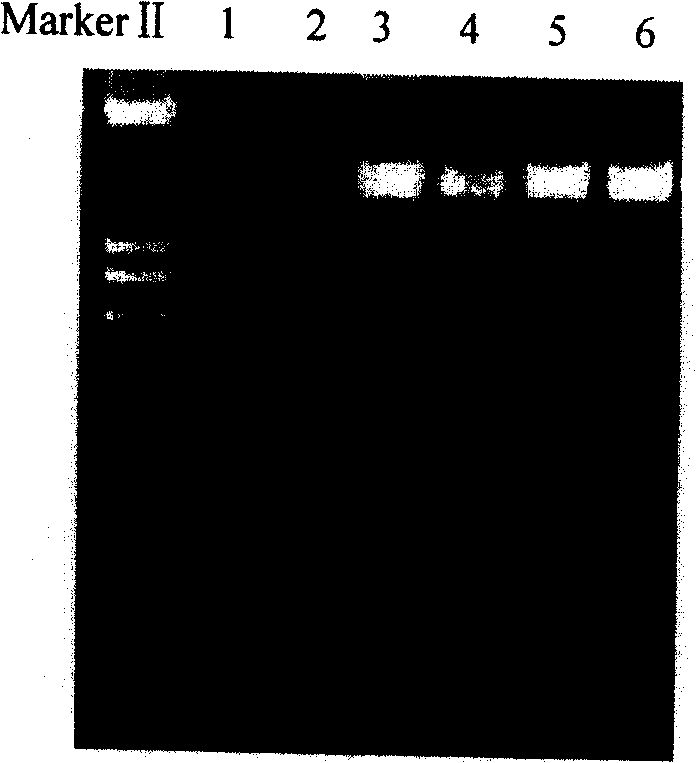Small quality fast extraction method for soil total DNA
An extraction method and soil technology, applied in the field of microbiology and molecular biology, can solve the problems of difficult separation of cells, time-consuming, uneconomical extraction, etc.
- Summary
- Abstract
- Description
- Claims
- Application Information
AI Technical Summary
Problems solved by technology
Method used
Image
Examples
Embodiment 1
[0027] Example 1: Total DNA Extraction from Orthic Anthrosols
[0028] The experimental soil was taken from the surface soil sample of the middle school affiliated to Huazhong Agricultural University in Wuhan City, Hubei Province, China (the soil is classified as dry-cultivated artificial soil, pH=5.87, and the classification is named Orthic Anthrosols), and the sample was passed through a sieve with an aperture of 2 mm × 2 mm , and then stored at -20°C until use. The specific operation steps are as follows:
[0029] (1) Making cracking tubes: Weigh 10 grams each of quartz sand and silica powder, wash with dilute nitric acid first, then wash with deionized water and soak overnight, then dry at 80°C, and accurately weigh the dried Each 0.3g of quartz sand and silicon dioxide powder is put into a 2ml centrifuge tube, and sterilized at 121°C for 30 minutes;
[0030] (2) Weigh 0.5 grams of soil sample into the lysis tube of step (1), add lysis buffer (preparation of lysis buffer...
Embodiment 2
[0042] Embodiment 2: PCR detection is done to the DNA extracted in embodiment 1
[0043] The DNA extracted in Example 1 was used as a template, and the designed primers: 338F 5' CTCCTACGGGAGGCAGCAG3' and 1492R5'GGTTACCTTGTTACGACTT3' were used to amplify soil microbial 16S rDNA (16S ribonucleosome RNA gene). The 16S rDNA of soil microorganisms were amplified by the indirect method, the kit method and the total soil DNA prepared by the method of the present invention without dilution and diluted 10 times as templates for PCR reactions. The PCR reaction system is as follows (50ul): ddH 2 O: 34.5ul; DNA: 2ul; 10×PCR buffer (TaKaRa): 5ul; 10×MgCl 2 (TaKaRa): 5ul; dNTP (Promega, 10mM each): 1ul; 16S rDNA primer 338F (50ng / ul): 1ul; 16S rDNA primer 1492R (50ng / ul): 1ul; Taq Enzyme (TaKaRa, 5U / ul) : 0.5ul. The PCR program is as follows: pre-denaturation: 94°C for 5 minutes; denaturation: 94°C for 45 seconds; annealing: 49°C for 45 seconds; extension: 72°C for 1.5 minutes; final ext...
Embodiment 3
[0045] Example 3: Enzyme digestion detection of DNA extracted using the method of the present invention
[0046] EcoR I (G ↓ AATTC) and Pst I (CTGCA ↓ G) double enzyme digestion (references: J. Sam Brook, D.W. Russell. Molecular Cloning Experiment Guideline) is done to the DNA extracted by the method of the present invention in Example 1 . Third Edition. Science Press. 2003). Enzyme digestion system (20ul): ddH 2 O: 11ul; 10×H buffer (TaKaRa): 2ul; EcoR I (TaKaRa, 15U / ul): 1ul; PstI (TaKaRa, 15U / ul): 1ul; DNA: 5ul. Digestion conditions: overnight at 37°C. Depend on image 3 It can be seen that the DNA after enzyme digestion presents a continuous band shape, which proves that the DNA is cut into small fragments in a smear shape, indicating that the DNA extracted by the method of the present invention can meet the requirements of enzyme digestion.
PUM
 Login to View More
Login to View More Abstract
Description
Claims
Application Information
 Login to View More
Login to View More - R&D Engineer
- R&D Manager
- IP Professional
- Industry Leading Data Capabilities
- Powerful AI technology
- Patent DNA Extraction
Browse by: Latest US Patents, China's latest patents, Technical Efficacy Thesaurus, Application Domain, Technology Topic, Popular Technical Reports.
© 2024 PatSnap. All rights reserved.Legal|Privacy policy|Modern Slavery Act Transparency Statement|Sitemap|About US| Contact US: help@patsnap.com










